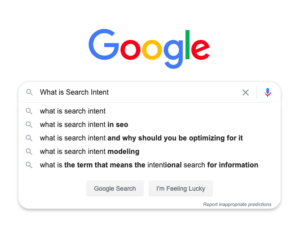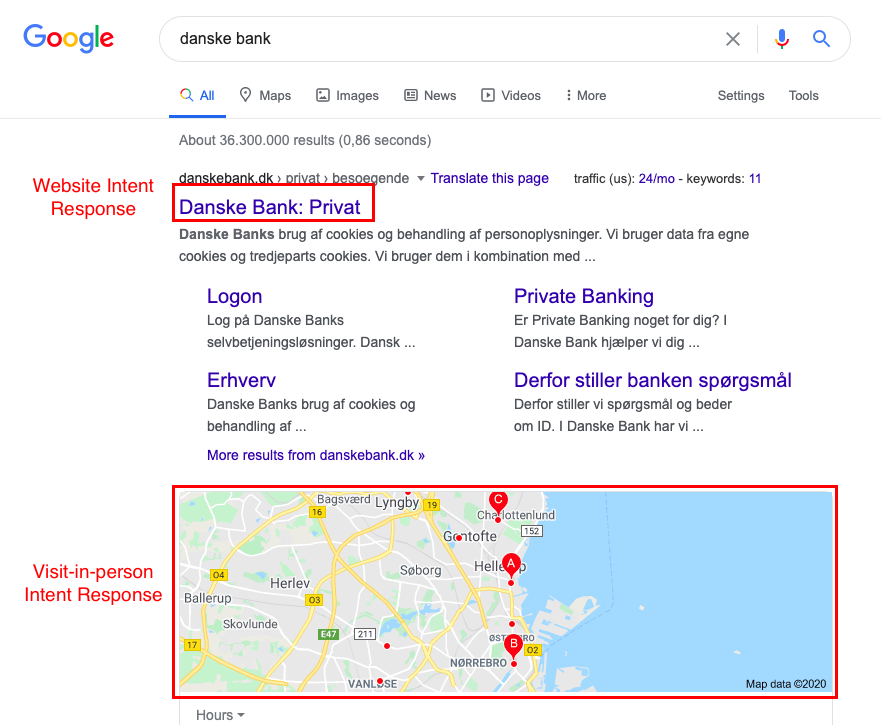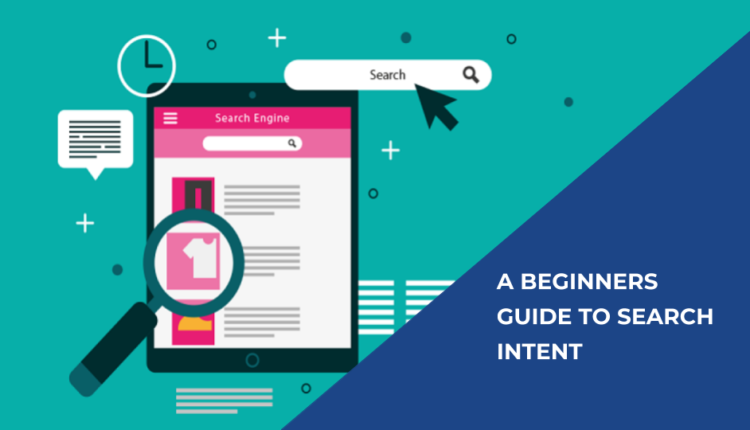Every day, there are more than 3 million searches happen per minute on Google and behind each search, there is some motivation and intention. In today’s article, we will take a deep dive into understanding the meaning behind search intent. We will also look into the different types of Search Intent. But more importantly, we will look into how marketers can use Search Intent for better targeting and marketing campaigns.
So, let’s start with what is Search Intent.
What is Search Intent?
Search intent – also known as User Intent or Audience Intent – defines the reason or motive behind a user’s search on search engines. This includes queries on search engines like Google or Bing, but also social media platforms or forums like Facebook or Quora. Regardless of the channel used, Google distinguishes five different types of searches.
- Know – answers the question “does the user want to know something?”;
- Do – when a user wants to perform an action;
- Website – when the user specifically wants to access a certain web page;
- Visit in person – when the user is searching for a location;
- Multi-Intent – a combination of two or more of the above intents.
Now we know the names of each intent, so let’s see what they actually mean.
1. Know query
With the Search Know query, you want to learn or inform yourself about something. According to the Quality Rating Guide, there is a separate category for every specific answer. But, for example, Know Simple searches return specific answers, such as facts, diagrams, etc. These searches tend to be correct and comprehensive and can be displayed in a relatively small space like a phone screen.

Search queries that do not have a correct definitive answer, are excluded from “Simple Know”. These are queries that are too complex to provide a short answer. Or, in which different users want to obtain different types of information or from different sources. However, searches for information on highly controversial topics are also excluded.
2. Do query
Google defines the search intent of a Do search as your desire to achieve a goal or perform an activity on a mobile phone. The objective or activity is not necessarily transactional, as is the case with the intent transactional search queries – we will get back to these later.
A Do search query can also involve downloading an application, as well as initiating a call, opening a website, or running an application. Basically, any type of interaction with websites or applications is a Do search, including commercial operations, such as a purchase.
Do searches also have their special subcategory, ” Device Action “. This refers to all actions in which the mobile phone is actively requested to perform an action for the user. This includes special requests, such as telling the phone to use the hands-free car kit. Either way, these device action requests have a clear intent and a specific action word. An example would be the command “Google, call Peter.”
3. Website Search query
A website search is for those who want to access a specific website or a page of it. This intention corresponds very well with navigational searches since the action always occurs concerning a specific website.
A website search can be as simple as “Youtube”, but also a search for “iPhone 11 pro 256GB pricerunner” is a perfect example of this intention. In simple terms, the user wants the response received to come from a single source.
4. Visit-in-person query
In this search intent, Google addresses increasingly rely on mobile phones as the last step on their search journey. Examples of this type of searches include queries such as “where can I find the nearest bank”. But also simple searches like a specific restaurant, a grocery shop, and other highly location-related searches.
However, users do not have to include the words “near me” in the query or any other combination that alludes to wanting to receive results close to their location. Google knows that we look for a restaurant, because, usually, we want to go to eat somewhere nearby. So naturally, the results will show the closest options based on our last known location. In these queries that Google relies heavily on Google Maps integrations in search and our mobile GPS function.

Google admits, however, that there are many examples where it is not possible to clearly distinguish whether the user wants to go to a website (website search query) or prefers to physically visit the store (in-person visit query search). Examples are searches for well-known brands such as Danske Bank or Apple store, which have a strong presence both online and offline.
In-person visit searches are also highly dependent on local search behavior. The example that Google uses, is searching for “la hacienda”. In this situation, users from Denmark can search for something completely different from users in other parts of the world. And this is simply because there is a restaurant with this name in San Antonio, Texas.
To remove the doubt as to whether a search query fits into the Visit-in-person search intent category, Google gives the following advice:
“Use your common sense when considering whether a search may have a Visit in Person search intent.”
5. Multiple User Intent Search
Not all search queries can be easily classified into a single search intent category. And, you don’t have to, because many search queries can have different search intentions at the same time.
Google lets its quality raters use their own judgment in multi-intent searches to decide which intent is most likely behind a particular search for a particular audience.
What are people’s intentions?
Now that we know what are the main types of searches, it’s time to look into the actual motivation between each of them. As mentioned, we are users who enter words with some intent into Google. We usually look for information, weather, a specific website, reviews, products, or anything else. There can be countless of these intentions. However, what marketers are interested in is the motivation behind the intent. More specifically, how to know all this and use it in marketing?
Luckily, about ten years ago, Rand Fishkin from Moz created a simple list where he categorizing the keywords typology based on intention, and it’s still up to date. Fishkin divided motivation as follows:
- Navigation Searches;
- Information Searches;
- Commercial Investigation;
- Transactional Searches.
1. Navigation searches
Navigation searches are when people make a query with the sole purpose of finding a specific. Naturally, the best-ranked websites show in the first results. So, the search journey might appear tricky if you seek something specific, because the keyword could be a homonym and have more than one meaning.
For example, if you search for a publishing platform Medium, you might find some other links to the word “Medium” which has zero connection to the platform. On the other hand, it is very dependable on the SEO ranking of the site as well.


2. Information searches
These keywords refer to specific information, tips, or guidelines where the user is trying to learn something new. Information searches often take the form of a question so it gets the desired answer faster.
For example:
- How do I rank higher on Google with SEO?
- How do I double traffic on my site?
- How Do Ads Follow Me Around the Web?

3. Commercial Investigation
According to Fishkin, these searches are somewhere between informational and transactional. For example, you are researching the latest smartphones because you plan to buy one. You don’t know which model, brand, or retailer to choose but there is already a clear shopping plan.
These searches are often associated with words like the top, best, comparison, etc. In this situation, you will search for “the best phones made in 2020”. Of course, this is just one example, and the research can evolve from there.

4. Transactional searches
The primary goal of these searches is a transaction. However, it does not have to be in the form of a purchase, it can also be about registering on a site, downloading an e-book, or any other similar action. These keywords are usually associated with specific products and can include words like promotion, discount, buy, e-shop, and more.
Using the same example as before, let’s say you were researching buying a new smartphone. But the results were unsatisfactory because the price was too high, or you didn’t find the brand you were actually looking for.
In this situation, a transactional search allows you to seek through different e-shops and retailers with the outcome of paying the least amount.

Should I care about the search intent?
In everyday life, it is very difficult, sometimes even impossible to make everyone happy with an article or any other type of content. And that is the reason why it makes sense to align the offer itself with the expectations of those users who hopefully will interact with your content.
If you think that your visitors want to find the best travel experiences in Europe, you must address exactly this intention and not try to sell them hotel reservations, by hook or by crook.
In general, information search queries will have a greater ability to target a wide audience, at the upper levels of your marketing funnel. Transactional searches, on the other hand, are very often much lower in the funnel, as the visitor usually already knows what they want and only has to decide where they are going to get it from.
The search navigations go from the center to the end of our funnel, because users already know on which website they want to get the information. In this group of intentions, it is important that you are able to convert visitors into customers. With the user’s search intent, you could consider the possibility of working on Google’s micro-moments.
Conclusion
Unfortunately, it is not possible to classify each search intent as transactional, informational, browsing, or visiting in person. Google has learned from its users that they do not want a single type of answer. Some of them will simply want general information about a product – a Know query for “Phone” – while others want information about a particular product – Apple’s iPhone.
For this last search, it is not clear if it is about Know query or Visit-in-Person query, since the user may be interested in knowing more about the product itself or knowing it personally, so a hybrid result appears in the SERPs (Search Engine Results Page), both informative and navigational.
What is clear though, is that you can only deliver the best results tailored to your users’ needs when you really understand what they are looking for. This makes it essential to understand both the intention and motivation behind their searches. And only in this way you can outline a strategy that creates the appropriate content for your target audience.

Comments are closed.